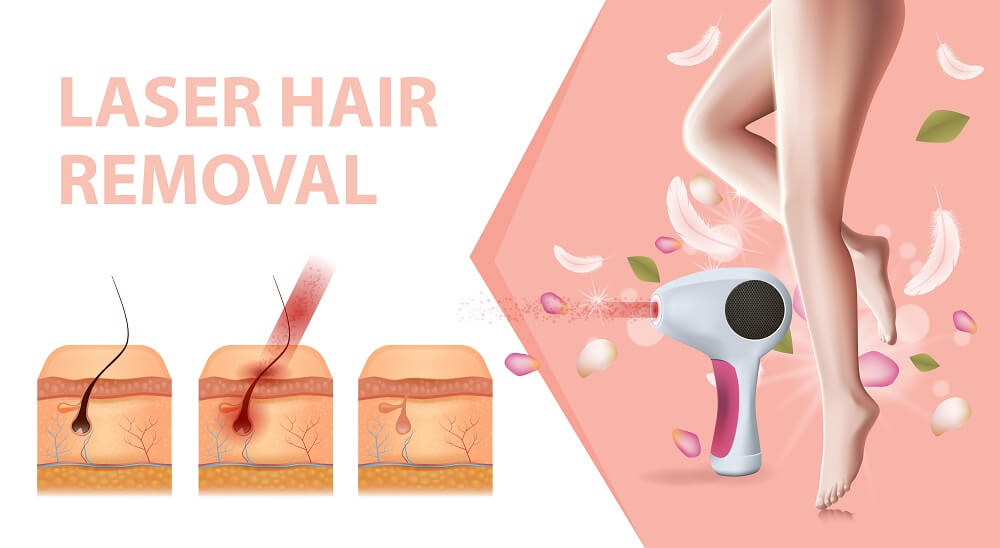Laser hair removal is a great choice instead of shaving or waxing, as it gives you longer-lasting results. But it’s important to know that there might be temporary side effects like skin irritation and shedding. It’s completely normal for hair to shed after laser hair removal. Laser hair removal is the best way to get rid of unwanted hair on your body permanently. In this blog post, we’ll explain what shedding after laser hair removal means, why it happens, and how to handle it.
What is shedding after laser hair removal?
Shedding is a natural and essential part of the laser hair removal process, and understanding it can help you navigate your journey toward smooth, hair-free skin. After undergoing a laser hair removal session, you may notice that the treated hair begins to shed in the following days. This shedding occurs as a result of the laser targeting the hair follicles, damaging them at their roots. Over time, the treated hairs will be pushed out of the follicles and gradually fall out, revealing hair-free skin.
Shedding is a positive indication that the treatment is working effectively, as it demonstrates the successful disruption of hair growth. The duration and intensity of shedding can vary from person to person, but typically, you can expect to see shedding within one to three weeks after your session. It’s important to note that shedding is not the same as regrowth; instead, it paves the way for new, finer hair to grow in place of the treated hair. As the treatment progresses through multiple sessions, you’ll notice a significant reduction in hair growth, leading to long-lasting results. Embrace the shedding process as it signifies progress towards your desired smooth, hair-free appearance.
How does laser hair removal treatment work?
Laser hair removal is a highly effective and popular method for achieving long-term hair reduction. The treatment utilizes a concentrated beam of light, known as a laser, which is directed toward the targeted area of the skin. The pigment in the hair follicles absorbs this intense light, which then transforms into heat. This heat damages the hair follicles at their root, inhibiting further hair growth. As a result, the treated hair eventually falls out during the shedding phase, leaving behind smooth and hair-free skin.
The process is precise and selective, as the laser targets dark, coarse hairs while leaving the surrounding skin undamaged. It’s important to note that multiple sessions are typically required for optimal results, as hair grows in different phases, and laser hair removal is most effective during the active growth phase. This versatile treatment can be used on various body areas, including the face, legs, underarms, and bikini lines. Laser hair removal offers the most convenient and effective solution for those seeking to say goodbye to unwanted hair and embrace a confident, hair-free lifestyle.
When does shedding start after laser hair removal?
Shedding is a normal and anticipated part of the laser hair removal process, and understanding its timing can help you navigate your hair removal journey. After undergoing a laser hair removal session, shedding typically begins around 7 to 14 days post-treatment. This shedding occurs as a result of the laser targeting and damaging the hair follicles at their roots during the session. Over the following days, the treated hairs are gradually pushed out of the follicles and shed naturally. It’s essential to recognize that shedding after laser hair removal is a positive sign that the treatment is effectively disrupting hair growth. As you progress through multiple sessions, you will notice a significant reduction in hair growth, leading to smoother and hair-free skin. Consistent and regular laser hair removal sessions increase the chances of targeting more hair follicles effectively, ultimately leading to successful and long-lasting results.
How to speed up shedding after laser hair removal
While shedding is a natural part of the laser hair removal process, there are certain steps you can take to encourage and accelerate this phase, leading to quicker and more noticeable results. First and foremost, staying consistent with your scheduled laser hair removal sessions is crucial. Adhering to the recommended treatment plan ensures that the laser effectively targets hair follicles in the active growth stage (anagen phase), maximizing the shedding process.
Additionally, keeping your skin hydrated and moisturized can contribute to smoother shedding. Moisturized skin helps the treated hairs to shed more easily and minimizes potential discomfort during the process. Exfoliating the treated area gently can also aid shedding by sloughing off dead skin cells, allowing hairs to break through more readily. However, following your dermatologist or technician’s advice on when and how to exfoliate to avoid any irritation is essential. By taking these steps, you can optimize the shedding process and reveal the radiant, hair-free skin you desire, making your laser hair removal journey even more rewarding.
How much hair should fall out after the first laser treatment?
During laser hair removal, the lasers can only kill hair when it’s in the active growth stage. During a single laser session, the laser device can only target approximately 15% of the hair, and these treated hairs will naturally fall out on their own, typically within 5 days or more after the procedure.
How many days after laser do you shed?
After the treatment, hair shedding typically starts within 7 to 14 days and will continue with each subsequent treatment until you achieve the desired level of hair removal that makes you happy. During this period, you might see some hair falling out while you shower or brush your skin.
What to expect after shedding stops?
Once the shedding process is complete, you’ll likely observe that the treated area looks smoother and free from hair. Nonetheless, keep in mind that laser hair removal isn’t a single treatment, and you may need several sessions to attain your desired results.
How many laser hair removal treatments do I need?
The amount of treatments needed to remove hair completely differs for each person, but generally, it falls between three to eight sessions. Laser hair removal is a safe and effective option for getting rid of hair, replacing traditional methods like waxing and shaving.
Conclusion
In conclusion, don’t worry if you notice shedding after laser hair removal; it means the treatment is doing well. Embrace this natural process as it helps make your skin smooth and free from hair. Laser hair removal is an amazing way to get rid of unwanted hair permanently, giving you more confidence. So, if you’re considering laser hair removal, know that shedding is a positive sign that you’re on the right track to achieve your desired results.



